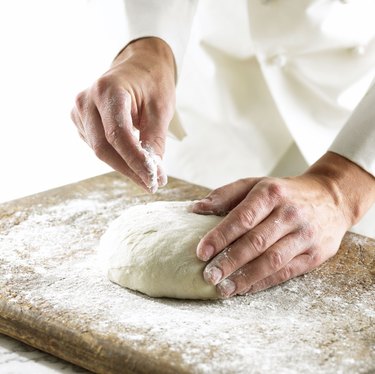
Unless you follow a no-knead bread recipe, which replaces kneading with time, you need to knead the dough before you let it rise and then bake it. Kneading plays a big role in the creation of bread. It allows the dough to develop gluten, the protein that gives bread its chewy texture and contributes to the overall structure of the loaf. You can use your own hands to knead or let a machine handle the job for you.
Stand Mixer: Advantages
Video of the Day
One of the biggest advantages of using a stand mixer to knead bread is that it makes the process much easier for you. You don't have to clear away a spot on the counter or get your hands dirty. Stand mixers are also able to handle sticky doughs, which have a high water content. If you try to knead wet doughs by hand, they are likely to cling to your fingers. A mixer also has the ability to knead very heavy doughs that would strain your hands if you tried to knead them yourself.
Video of the Day
Hand Kneading: Advantages
While using a stand mixer is less work, hand kneading has its advantages. You can't over-knead the dough when you work by hand. Kneading by hand can also lead to the development of more gluten, according to "Cook's Illustrated." More gluten means a better texture to the finished bread. Kneading by hand also allows you to get a feel for dough and lets you feel the way gluten forms as you work the dough.
Stand Mixer: Disadvantages
A stand mixer can handle the dough pretty roughly and sever the strands of gluten that form, affecting the finished quality of the bread. The mixer can also cause the dough to overheat as it kneads. Dough can increase in temperature by up to 3 degrees per minute when a stand mixer kneads it. If a dough is too warm, it will rise too quickly and can over-proof. Kneading a heavy dough with a stand mixer can cause the motor to overheat or the machine to jostle on the countertop and potentially fall from the counter. Another big disadvantage of using a stand mixer is the cost of the machine. Mixers are expensive and it might not make sense to invest in one unless you bake bread often.
Hand Kneading: Disadvantages
If you try to knead wet dough by hand, it is often tempting to add a lot of extra flour to make the dough more manageable. Adding too much flour makes the finished bread tough. Hand kneading is also very messy, as you typically end up with flour on the counter and pieces of dough stuck to your fingers. Depending on how often you make bread, you also risk developing a repetitive stress injury from kneading by hand.